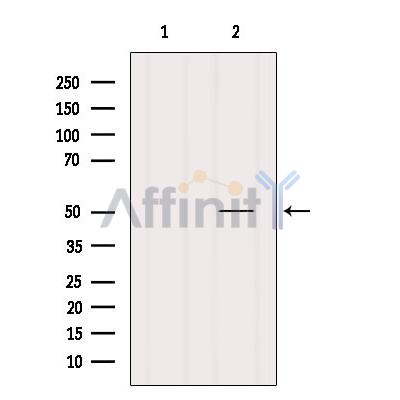CREST Antibody - #DF12262
| Product: | CREST Antibody |
| Catalog: | DF12262 |
| Description: | Rabbit polyclonal antibody to CREST |
| Application: | WB IHC |
| Reactivity: | Human, Mouse, Rat, Monkey |
| Prediction: | Pig, Horse, Sheep, Rabbit, Dog, Chicken, Xenopus |
| Mol.Wt.: | 50 kDa; 43kD(Calculated). |
| Uniprot: | O75177 |
| RRID: | AB_2845067 |
Related Downloads
Protocols
Product Info
*The optimal dilutions should be determined by the end user. For optimal experimental results, antibody reuse is not recommended.
*Tips:
WB: For western blot detection of denatured protein samples. IHC: For immunohistochemical detection of paraffin sections (IHC-p) or frozen sections (IHC-f) of tissue samples. IF/ICC: For immunofluorescence detection of cell samples. ELISA(peptide): For ELISA detection of antigenic peptide.
Cite Format: Affinity Biosciences Cat# DF12262, RRID:AB_2845067.
Fold/Unfold
Calcium-responsive transactivator; CREST; CREST_HUMAN; KIAA0693; LP2261; MGC26711; MGC78386; sarcoma translocation gene on chromosome18like1; SS18; SS18-like protein 1; SS18L1; SSXT; synovial sarcoma translocation; synovial sarcoma translocation gene on chromosome 18-like 1; SYT homolog 1;
Immunogens
A synthesized peptide derived from human CREST, corresponding to a region within the internal amino acids.
- O75177 CREST_HUMAN:
- Protein BLAST With
- NCBI/
- ExPASy/
- Uniprot
MSVAFASARPRGKGEVTQQTIQKMLDENHHLIQCILEYQSKGKTAECTQYQQILHRNLVYLATIADSNQNMQSLLPAPPTQNMNLGPGALTQSGSSQGLHSQGSLSDAISTGLPPSSLLQGQIGNGPSHVSMQQTAPNTLPTTSMSISGPGYSHAGPASQGVPMQGQGTIGNYVSRTNINMQSNPVSMMQQQAATSHYSSAQGGSQHYQGQSSIAMMGQGSQGSSMMGQRPMAPYRPSQQGSSQQYLGQEEYYGEQYSHSQGAAEPMGQQYYPDGHGDYAYQQSSYTEQSYDRSFEESTQHYYEGGNSQYSQQQAGYQQGAAQQQTYSQQQYPSQQSYPGQQQGYGSAQGAPSQYPGYQQGQGQQYGSYRAPQTAPSAQQQRPYGYEQGQYGNYQQ
Predictions
Score>80(red) has high confidence and is suggested to be used for WB detection. *The prediction model is mainly based on the alignment of immunogen sequences, the results are for reference only, not as the basis of quality assurance.
High(score>80) Medium(80>score>50) Low(score<50) No confidence
Research Backgrounds
Transcriptional activator which is required for calcium-dependent dendritic growth and branching in cortical neurons. Recruits CREB-binding protein (CREBBP) to nuclear bodies. Component of the CREST-BRG1 complex, a multiprotein complex that regulates promoter activation by orchestrating a calcium-dependent release of a repressor complex and a recruitment of an activator complex. In resting neurons, transcription of the c-FOS promoter is inhibited by BRG1-dependent recruitment of a phospho-RB1-HDAC1 repressor complex. Upon calcium influx, RB1 is dephosphorylated by calcineurin, which leads to release of the repressor complex. At the same time, there is increased recruitment of CREBBP to the promoter by a CREST-dependent mechanism, which leads to transcriptional activation. The CREST-BRG1 complex also binds to the NR2B promoter, and activity-dependent induction of NR2B expression involves a release of HDAC1 and recruitment of CREBBP (By similarity).
Nucleus. Chromosome>Centromere>Kinetochore.
Note: Localizes to nuclear bodies. Colocalizes with SGO1 at kinetochore (By similarity).
Ubiquitous; with lowest levels in spleen.
The MFD (multi-functional domain) domain is involved in transcription transactivation, nuclear body targeting and dimerization.
Belongs to the SS18 family.
Restrictive clause
Affinity Biosciences tests all products strictly. Citations are provided as a resource for additional applications that have not been validated by Affinity Biosciences. Please choose the appropriate format for each application and consult Materials and Methods sections for additional details about the use of any product in these publications.
For Research Use Only.
Not for use in diagnostic or therapeutic procedures. Not for resale. Not for distribution without written consent. Affinity Biosciences will not be held responsible for patent infringement or other violations that may occur with the use of our products. Affinity Biosciences, Affinity Biosciences Logo and all other trademarks are the property of Affinity Biosciences LTD.
